Natural beauty of Hoang Xa mountain
In the past, the Xu Doai region was famous for its “16 famous mountains”. In Hoang Xa commune, there was one of the 16 special mountains. This was a limestone mountain, running in an arc shape from the Northeast, curving to the West and ending in the Southeast, with the center of the arc facing East. Hoang Xa Cave is located at the foot of the mountain, in the center of the arc.
Hoang Xa Cave is one of the special caves in the ancient Xu Doai region. This is a perforated cave, from the top of the mountain there are a few openings that let in direct natural light to illuminate the bottom of the cave. The cave has a dome shape, from the base of the cave to the dome height of about 25m, the cave has an area of about 200m². Hoang Xa Cave has 2 doors facing each other, connected by a side door inside the cave. The main door faces East, the side door faces West.


In front of the Hoang Xa cave, there are still 3 tomb towers built of bricks and stones, on which are carved Chinese characters. Inside the cave, there are also stalactites, with wild and natural features, forming many different shapes and bands, with unique features that allow viewers to imagine many different shapes.
Not only Hoang Xa cave, Hoang Xa mountain cluster also includes many relics such as: Thuong Temple (also known as Tu Dong De Quan Temple), the temple has 3-room architecture, where Van Xuong De Quan is worshiped on the top of the mountain. The foot of Hoang Xa mountain is the location of a cool blue lake, in the middle of the lake is a water pavilion. The water pavilion in the middle of Hoang Xa lake has the characteristics of Northern folk architecture including 2 ancient-style floors with 8 sloping roofs and 8 curved roofs, creating a harmonious and graceful look for the architecture of the water pavilion.
Historical stories
Cao Ba Quat (1808 - 1855) was a teacher at Quoc Oai district. He saw the unique beauty of Hoang Xa land, so he wrote 4 poems on Sai Son mountain cliffs and today he still leaves his handwriting in the cave. Witnessing the country's misery under the rule of the Nguyen Dynasty, in December 1854, he commanded the uprising army to rise up against the Nguyen Dynasty government in My Luong, Son Tay province (today My Luong commune, Chuong My district, Hanoi). Cao Ba Quat's army fought a fierce battle with the Nguyen Dynasty's army led by Son Tay commander Le Thuan at the foot of Hoang Xa mountain. In this battle, Cao Ba Quat died in battle.
In the Hoang Xa cave, there are many steles carved on the cave walls. In particular, at the center of Hoang Xa cave, there is a statue of Dong Cac Dai Hoc Si Cao Xuan Duc (1843 - 1923). Cao Xuan Duc was an upright and patriotic mandarin. He held many different positions such as Kinh Lich, Tri Huyen, An Sat, Tong Doc, Tong Tai, Thuong Thu, Dong Cac Dai Hoc Si... Due to disagreements with Truong Nhu Cuong, he did not sign the petition to the king, and was later demoted to Tri Phu Quoc Oai. Moved by the spirit of Dai Hoc Si Cao Xuan Duc, after his death, the people of Quoc Oai carved a statue of him in the middle of the cave to worship him.
Hoang Xa revolutionary base
After the collapse of the feudal regime, the Democratic Republic of Vietnam was born, however, at the end of September 1945, France returned to invade our country. Under the leadership of the Party, the entire army and people continued to unite to expel the colonialists. In the Hoang Xa mountain area, many important events took place associated with our people's resistance war against the French. Before retreating to Viet Bac, on the night of March 2nd to the morning of March 3rd, 1947, President Ho Chi Minh chaired a meeting of the Government Council and rested at Hoang Xa cave. During the resistance war against French colonialism, Hoang Xa cave was also the residence of the Inter-zone 2 Resistance Committee.
On April 12, 1949, the French colonialists used 2,000 soldiers, including armored vehicles, artillery, and additional aircraft support, to sweep the Hoang Xa mountain and cave area. Faced with the enemy's continuous and fierce attacks, the 385th Company coordinated with the local army, people, and guerrillas to organize a coordinated counter-sweep. In this battle, many French invaders were killed and captured, which contributed to promoting the fighting movement and raising the patriotism of our army and people in the long resistance war against the French colonialists. In the fight to protect the homeland, many beloved children of the Vietnamese motherland were sacrificed. To commemorate this sorrowful day, every 15th day of the 3rd lunar month, the local people organized a memorial day. Later, the Quoc Oai District Martyrs Cemetery was also built in front of Hoang Xa Cave.

In 1972, the US imperialists escalated the war, raiding and bombing the North, Hoang Xa cave was chosen by the Government as the place to store the national treasury. In December 1972, the Voice of Vietnam Radio Station in Me Tri was destroyed by American B52 bombs, immediately from Hoang Xa cave, current information about the resistance war and the Central Party's instructions were continuously transmitted to the people of the whole country and the international community.
Only about 20km west of Hanoi city center, with convenient traffic conditions, Hoang Xa cave is an ideal destination for domestic and foreign tourists. Coming to Hoang Xa cave is not only a place to visit the scenic spots of the Doai region, but also a place for tourists to have more interesting historical stories, a "red address" for the younger generation to have more understanding about the painful history of struggle of our army and people.
Hoang Xa Cave is one of the relics and architectural works: Thay Pagoda and the rocky mountain area of Sai Son, Hoang Xa, Phuong Cach (Quoc Oai district, Hanoi) ranked as a special national relic by the Prime Minister's Decision 2408/QD-TTg on December 31, 2014.










